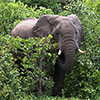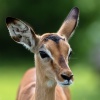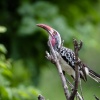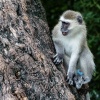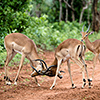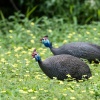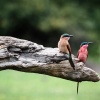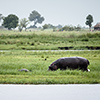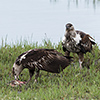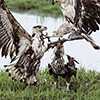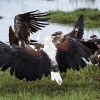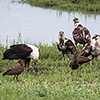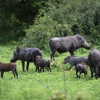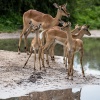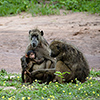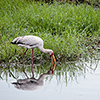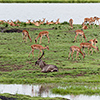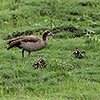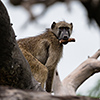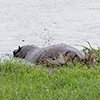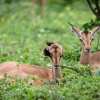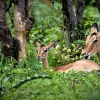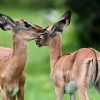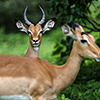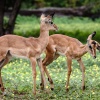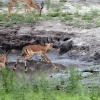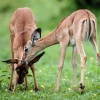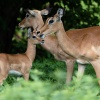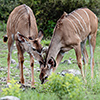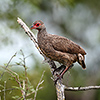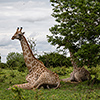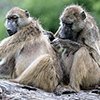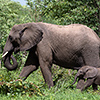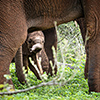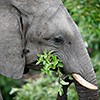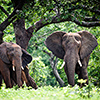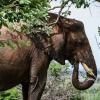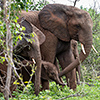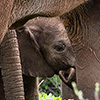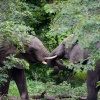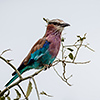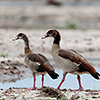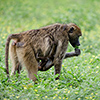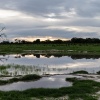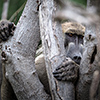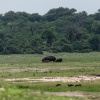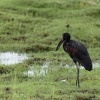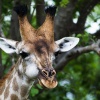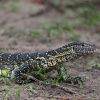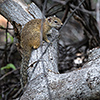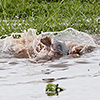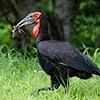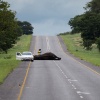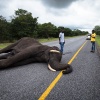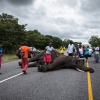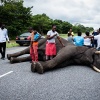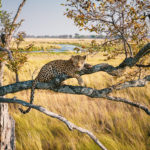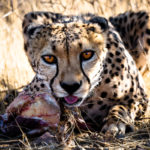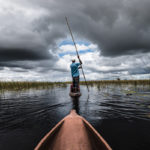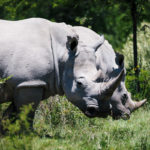Chobe River – Botswana’s Elephant Paradise
Chobe River and Zambezi, Botswana’s north is pretty much under the influence of water making the local vegetation literally running to leafs. That place is paradise to the most likeable pachyderms of the world: Elephants.
Also 12 years ago the sheer mass of elephants I’ve seen at Chobe National Park let my jaw drop. I have never ever seen so many elephants again, not in life and even nor in TV. The sunset boat cruise on Chobe River is yet unforgotten for me as I could see those animals very close and in combination with their most beloved toy, that is water.
Now, 12 years later, I’ve got the professional camera gear to capture all that photographically. Self-evidently I wanted to encounter a similar experience again and went back to Chobe, also because Kasane, Chobe’s main town, offers good opportunities to cross into Zimbabwe to see the Victoria Falls. Only weather-wise things could have been better as the often diffuse light conditions do not stage the animals in the best way possible. Anyway, let’s make the best out of it :-)
The morning games drives at Chobe National Park do not reveal all too much. That changes in the evening, but in rainy season often the days start cloudy and also the animals kick off their things at a leisurely pace. In the far distance I can spot some hippos having breakfast while at the riverside of Chobe a couple of fish eagle fight for the carcase of a catfish. Catfish often can be seen in the morning swimming and hunting in the shallow puddles on the riversides.
It doesn’t take much time and the fish eagles’ fight for food get joined by a couple of brown hamerkops as well as in the end by a big African fish eagle. Of course the latter and strongest of all birds wins the race and finishs the remains of the catfish. The birds’ yelling is remarkable, but doesn’t really bother the baboons living in the tree next door. With dedication they indulge themselves in pair grooming while having a curious look at the photographer from time to time.
Step by step the national park awakens. Sitting on old branches and in the trees around colourful bee-eaters start their day waiting for insects coming too close. At their feet an army of guineafowl couples roams about on the search for food. A bunch of warthogs, returning from a mudbath, startles them up. Loudly cackling they disappear in the bush. Driving through the national park I meet plenty of red-billed hornbills doing their job, meaning giving a warning call to other animals as there’s something suspicious, an approaching car, happening.
The park’s vegetation is also heaven to countless of Impala. In the western and less visited part of Chobe they relax in the grass taking no further notice of me, the approaching human. It seems as if I found the kindergarten as the young Impala came into the world only a few days ago. Right in front of me they play with each other and jump around. Their socialising gets only interrupted by two young males fighting for the favour of a female Impala. All things called clouds aside, the heat starts to cut through. Many animals disappear and spend the noon time in the shade of trees, so do even the giraffes.
Dashing through the park with the jeep makes no sense at all. As soon as being faster than 20km/h all animals escape quickly because of the noise. Such a panic bears quite some danger to giraffes as they can stumble. Often that ends up with bone fractures, what means death for those wonderful animal.
In the morning and mid morning it is hard to meet elephants. That was also the case 12 years ago. On the search for them I bump into soldiers camping in the bush. I am not allowed to take photos, but talking is ok. They are protecting the game from poachers.
The sheer mass of African elephants, what Chobe is known for worldwide, you can witness in the evening, when the animals come down to the river for having fun in the water and drinking. They start their little migration already at late afternoon and indeed, after a several hours game drive I can now see an elephant family of ~25 animals walking through the bush. Getting closer and closer they always surround their precious little baby, that apparently has quite some interest for my jeep.
Getting closer with the baby the rowdy younger elephants approach me and make clear unmistakably that I have to move out, now. Only two of the African mammals are able to screw up a car, that is a buffalo or elephant. Hence I put the jeep into reverse and back out. The jeep is fully insured but that doesn’t also mean I should take ‘advantage’ of that.
While distancing from the one group of elephants I see a second one in the far distance. It’s a majestic view to see the giant bull and leader waving its large ears and enjoying the shade of a tree. Its shoulders must be some 4 metres high, what is a rare but possible height for those animals.
The Chobe elephants often appear brownish, that because of a mudbath they have recently taken. The photo I take of that scene is not 100% sharp. On the one hand because of a 600mm focal length but also, and mainly, because of mirage, the flickering of hot air. Mirage belongs to Africa the same way elephants do. They are part of the scene, hence belong tom my photo and I have to live with an only 99% sharpness.
Unfortunately after having left Chobe I realise that the evening sundowner boat cruise offers the best possibility to watch the animals closely, hence I should have joined it even though for many people its more about booze than about nature. Anyway. The next morning I register at the national park gate for a free of charge transit as I move towards the Caprivi strip and Namibian border.
Riding towards the border I see something grey and massive lying on the street. I am the second to see a dead elephant bull having perished on the road between Kasane and Ngoma border post. It wasn’t a car accident, nor poachers. The animal died of natural causes, that is a weak heart.
Also for Africans that is not a picture they can see every day. Cars stop, people flock together and watch as well as touch the dead giant, but also, being completely self-absorbed, like the western way of life set as example, they start to take selfies and trivialize the once proud animal. No one of them notices the very rare southern ground hornbill only a couple of metres away.

